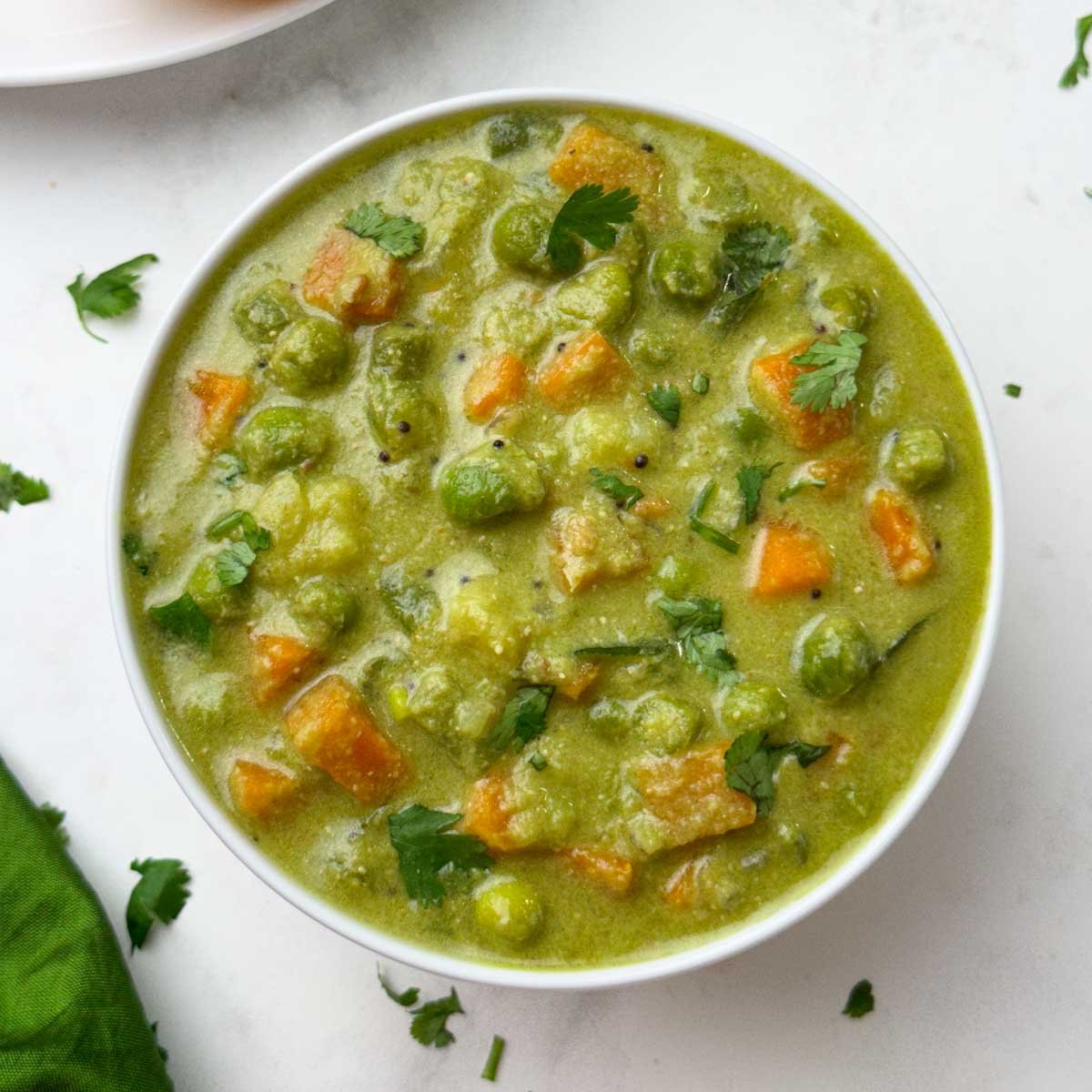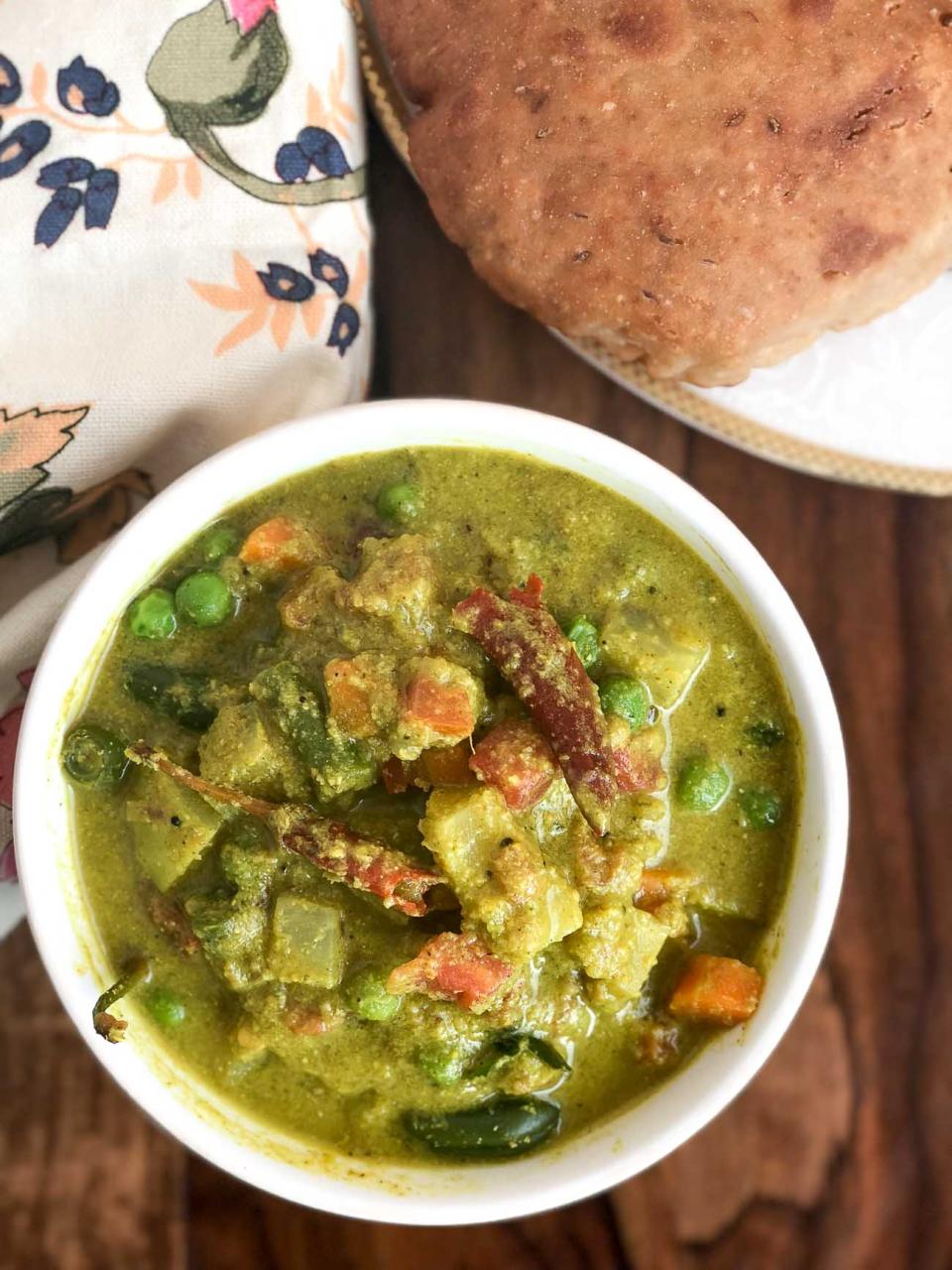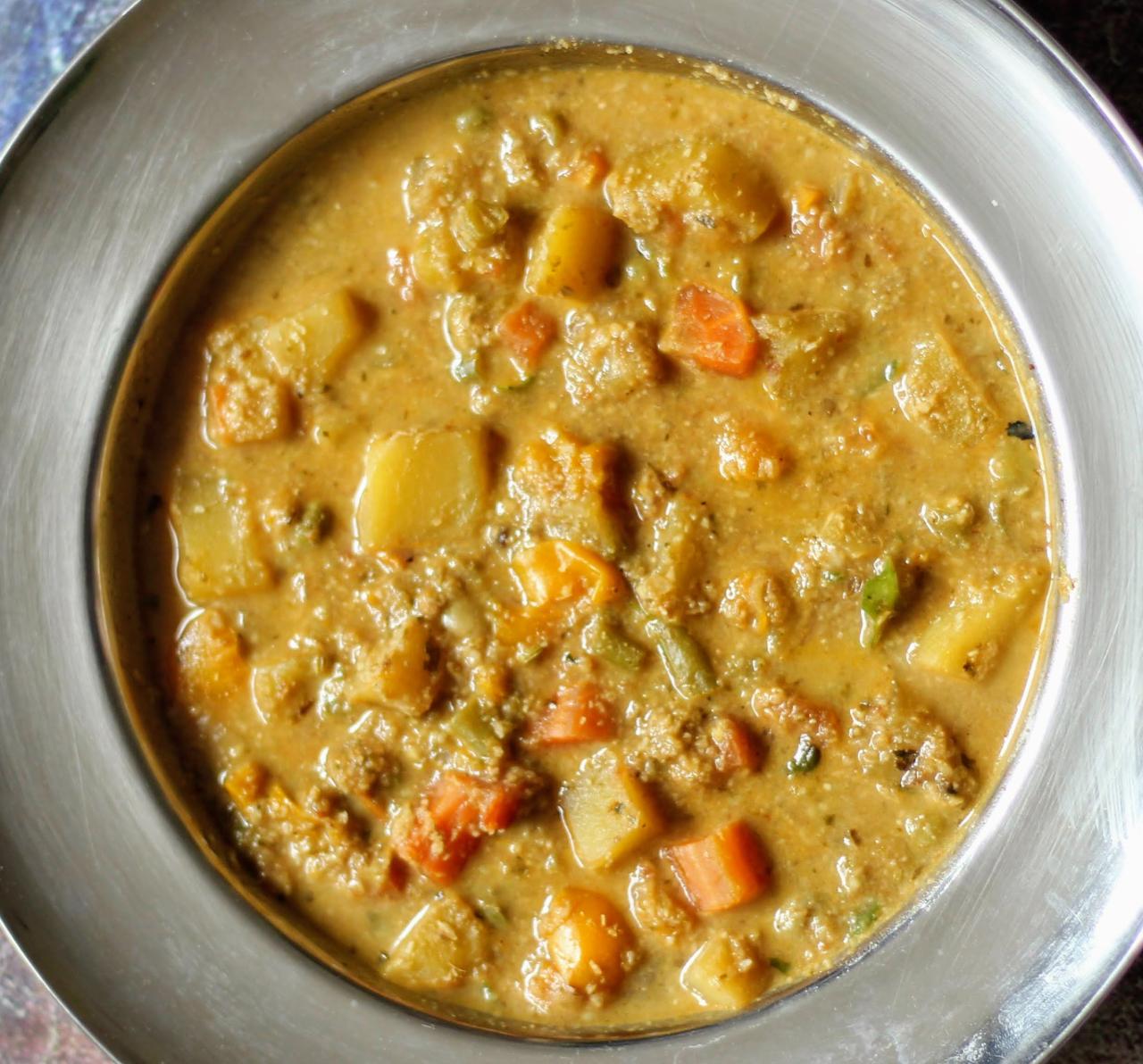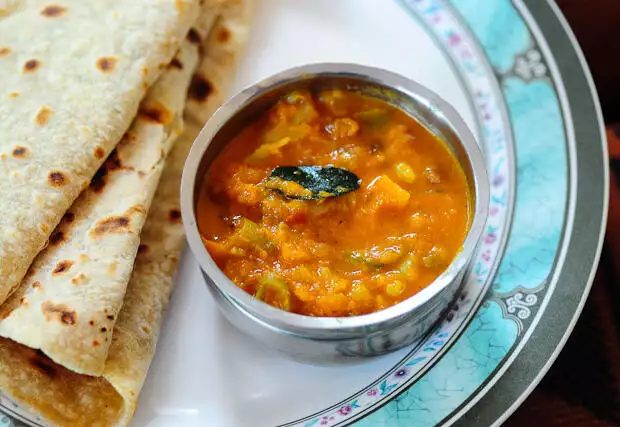Vegetable Sagu is a flavorful and nutritious dish hailing from the regions of Karnataka in South India. It is a kind of mixed vegetable curry that is aromatic, rich, and creamy, often made with a combination of vegetables like carrots, beans, potatoes, peas, and cauliflower. The base of the Sagu is formed by a masala paste made from coconut, fried gram, green chilies, coriander seeds, cumin seeds, cinnamon, cloves, cardamom, and poppy seeds, all blended together with some water to form a smooth paste.
The unique feature of Sagu is its blend of spices and coconut, lending it a distinct taste that’s both spicy and mild, with a hint of sweetness from the coconut. The dish is customarily flavored with a tempering (tadka) of mustard seeds, curry leaves, and asafoetida, which adds another layer of depth to its overall flavor profile.
Vegetable Sagu Recipe


Vegetable Sagu
Equipment
- 1 large skillet
- 1 blender
Ingredients
- 2 teaspoons corn oil
- 1 teaspoon cumin seeds
- 2 curry leaf sprigs
- 1 onion finely chopped
- 2 cups chunked mixed vegetables such as cauliflower, peas, beans, carrots, potatoes,
- zucchini
- 21/2 to 3 cups water divided
- 11/2 teaspoons salt
- 3 tablespoons roasted split chickpeas
- 1/2 cup shredded fresh coconut or frozen, thawed to room temperature
- 3 whole cloves
- 1 2-inch cinnamon stick
- 3 green cardamom pods
- 1 teaspoon peppercorns
- 3 green chiles
- 1 teaspoon poppy seeds
- 2 garlic cloves
- 5 fresh mint leaves
- 4 tablespoons chopped fresh cilantro divided
Instructions
- In a large skillet or wok over medium heat, heat the oil.
- Add the cumin seeds and curry leaves. Cook for 30 seconds.
- Add the onion and cook for 5 minutes, or until the onion is soft and translucent.
- Add the mixed vegetables, 1 cup of water, and the salt. Cover the skillet and cook for 8 to 10 minutes, until the vegetables are soft and tender.
- In a blender, combine the roasted split chickpeas, coconut, cloves, cinnamon, cardamom, peppercorns, green chiles, poppy seeds, garlic, mint, and 2 tablespoons of the cilantro. Pulse a few times to grind. With the blender running, slowly add 1⁄2 cup of water until a smooth paste forms. Transfer the masala to a bowl. Rinse the blender with 1⁄2 cup of water and set aside (do not discard).
- Once the vegetables are soft and tender, add the masala paste and the water used to rinse the blender to the skillet. Mix well. Simmer for 5 to 7 minutes, or until the raw smell of the paste is gone. If you prefer a thinner consistency, add 1⁄2 to 1 cup of water and bring it to a boil. If not, turn off the heat and stir in the remaining 2 tablespoons of cilantro.
Notes
Cooking Tips about Vegetable Sagu

- Choose a Variety of Vegetables: To make your Sagu colorful and nutritious, include a mix of vegetables such as carrots, beans, potatoes, peas, and cauliflower.
- Use Fresh Coconut: If possible, use fresh grated coconut to make the masala paste as it imparts a richer flavor compared to desiccated coconut.
- Roast the Spices: Dry roasting the coriander seeds, cumin seeds, cinnamon, cloves, cardamom, and poppy seeds enhances their flavors before they are ground into the masala paste.
- Grind to a Smooth Paste: Ensure that the masala paste is ground smoothly with adequate water, which helps in creating a creamy texture for the Sagu.
- Control the Consistency: Keep an eye on the amount of water you add while cooking. Vegetable Sagu should be a thick, rich gravy, not too watery.
- Cook Veggies to Correct Doneness: Some veggies take longer to cook, so start with those and add the softer veggies later, ensuring everything is cooked to perfection without becoming mushy.
- Balance the Flavors: Adjust the green chilies based on your spice preference, but remember that the coconut masala will mellow out some of the heat.
- Proper Tempering: The tempering (tadka) with mustard seeds, curry leaves, and asafoetida is critical in providing the iconic taste, so don’t skip this step.
- Simmer After Mixing: To blend the flavors well, bring the Sagu to a simmer after adding the masala paste to the cooked vegetables.
- Check Seasoning: Before serving, adjust the salt and any other seasoning needed to ensure the Sagu is to your liking.
Serving suggestions about Vegetable Sagu

- Alongside Puris: The thickness of the Sagu makes it a perfect accompaniment for deep-fried Indian bread like puris.
- With Chapatis or Rotis: The mild spiciness and creaminess of the Sagu pairs well with these whole wheat flatbreads, making for a wholesome meal option.
- As a Side Dish for Breakfast: Serve it with other breakfast items like idlis or vadas for a hearty South Indian breakfast.
- Include in a Thali: As part of a traditional thali that may include rice, pickle, papadum, and other curries, allowing diners to enjoy a variety of flavors and textures.
- With Rava Idli: Try Sagu with semolina-based steamed cakes called rava idli as an alternative to the classic pairing.
- Parotta Compliment: Partner the Sagu with flaky, layered parottas (Kerala or Malabar style) for a satisfying dinner.
- Neer Dosa Pairing: Light and delicate neer dosas also make a compatible pair with the substantial nature of Vegetable Sagu.
Top 5 FAQs about Vegetable Sagu

- What vegetables are traditionally used in Vegetable Sagu? Traditionally, a mix of vegetables such as carrots, beans, potatoes, peas, and cauliflower is used in Vegetable Sagu to create a colorful and nutritious dish.
- Can I use frozen vegetables for making Vegetable Sagu? Yes, you can use frozen vegetables for convenience, but fresh vegetables are recommended for the best flavor and texture. If using frozen, ensure they are thawed and water is drained well to avoid a watery gravy.
- Is it necessary to use fresh coconut for the masala paste? While fresh grated coconut is preferred for its rich flavor, desiccated coconut or coconut milk can be used as substitutes if fresh coconut is not available. The fresh coconut, however, imparts a more authentic taste.
- How do I achieve the right consistency for Vegetable Sagu? Keep an eye on the amount of water added during cooking. Adjust the consistency before serving; if it’s too thick, thin it out with a little water, and if it’s too thin, simmer it for a bit longer to achieve a thick, creamy gravy.
- Can Vegetable Sagu be part of a Thali? Yes, include Vegetable Sagu in a South Indian thali, offering a diversity of tastes and textures when served alongside other dishes like rasam, poriyal, and papadam.
Vegetable Sagu stands out in South Indian cuisine as a comforting, flavorful, and versatile curry that perfectly embodies the nuanced flavors of Karnataka. Its rich texture and aromatic blend of spices combined with a variety of vegetables make it not just a treat for the palate but also a nourishing meal. A well-made Vegetable Sagu features a harmony of mild spice from green chilies, sweetness and creaminess from coconut, and a tempting aroma from the tempering of mustard seeds, curry leaves, and asafoetida.

Leave a Reply